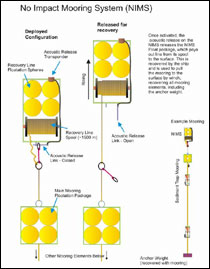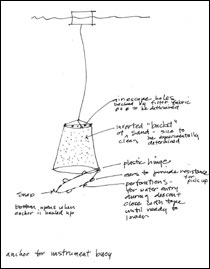Press Releases
FOR IMMEDIATE RELEASE
NOAA06-R411
February 28, 2006
CONTACT:
Rachel Saunders/MBNMS
(831) 647-4237
Kim Fulton-Bennett/MBARI
(831) 775-1835
NOAA ANNOUNCES WINNERS IN COMPETITION TO DESIGN AN ENVIRONMENTALLY FRIENDLY ANCHOR
The National Oceanic and Atmospheric Administration’s (NOAA) Monterey Bay National Marine Sanctuary and the Monterey Bay Aquarium Research Institute (MBARI) announced today the winners of their design competition for an “environmentally friendly” anchor. The competition, initiated in spring 2005, offered two $400 prizes for the best design for a reusable anchor and the best design for a “disposable” anchor (using materials that minimize environmental impacts). The contest focused on anchors that could be used to secure scientific instruments to the seafloor.
“Our goal with the contest was to raise awareness among scientists about the desirability of removing scientific equipment from the sanctuary after research projects are completed,” said Acting Sanctuary Superintendent Karen Grimmer. “We would rather that researchers left behind nothing but bubbles.”
More than a dozen entries were received from across the United States, including one from a 16-year-old high school student. A panel of marine engineers and environmental scientists evaluated each entry based in its environmental impacts, feasibility, and cost-effectiveness. Despite competition from across the country, the winners of both awards came from the Monterey Bay area.
The best “disposable” anchor design was submitted by Arrol Lund of Pacific Grove. This anchor uses an inverted plastic “bucket” filled with sand. A lid on the bottom of the bucket keeps the sand inside while the anchor is being lowered to the seafloor. However, when the anchor is lifted up, the lid flops open, releasing the sand onto the seafloor. This makes the anchor light enough to be hauled to the surface easily.
The best reusable anchor design was submitted by MBARI’s Dr. Jim Barry and two MBARI marine technicians, Mike Conway and Mike Burczynski. Their design addresses a common problem for oceanographers—how to recover instruments that are anchored to the bottom but float within the water column rather than at the surface, and are thus inaccessible to surface vessels. To address this problem, the team suggests attaching a long reel with a float onto the line that holds the instruments. When the experiment is complete, the reel would be released automatically, and would then float to the surface, spooling out line as it goes. After the float and reel reach the surface, researchers would use the line to pull up both their instruments and their anchor.
The next steps for this project include convening discussions with west coast researchers who commonly need to deploy large anchors. Discussions will focus on further evaluating and refining design and cost effectiveness issues relating to possible future installations.
The Monterey Bay National Marine Sanctuary stretches along 276 miles of central California coast and encompasses more than 5,300 square miles of ocean area. Renowned for its scenic beauty and remarkable productivity, the sanctuary supports one of the world’s most diverse marine ecosystems, including 33 species of marine mammals, 94 species of seabirds, 345 species of fishes and thousands of marine invertebrates and plants.
The NOAA National Marine Sanctuary Program seeks to increase the public awareness of America’s marine resources and maritime heritage by conducting scientific research, monitoring, exploration and educational programs. Today, the sanctuary program manages 13 national marine sanctuaries and one coral reef ecosystem reserve that together encompass more than 150,000 square miles of America’s ocean and Great Lakes natural and cultural resources
The National Marine Sanctuary program is managed by the National Ocean Service which is an office of the National Oceanic and Atmospheric Administration (NOAA), an agency of the U.S. Commerce Department. NOAA is dedicated to enhancing economic security and national safety through the prediction and research of weather and climate-related events and providing environmental stewardship of our nation’s coastal and marine resources. Through the emerging Global Earth Observation System of Systems (GEOSS), NOAA is working with its federal partners and nearly 60 countries to develop a global monitoring network that is as integrated as the planet it observes.
 |  | | Right: Best "disposable" anchor design submitted by Arrol Lund of Pacific Grove, Calif. Credit: NOAA Left: Best reusable anchor design submitted by Jim Barry and two marine technicians, Mike Conway and Mike Burczynski, from the Monterey Bay Aquarium Research Institute. Credit: NOAA/MBARI |
On the Internet:
NOAA - http://www.noaa.gov
National Ocean Service - https://oceanservice.noaa.gov
National Marine Sanctuary Program - http://sanctuaries.noaa.gov
Monterey Bay National Marine Sanctuary - http://montereybay.noaa.gov
Monterey Bay Aquarium Research Institute - http://www.mbari.org/
|





